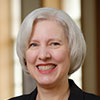This article is more than 5 years old.
One session I attended had possible practical application for us and is summarized immediately below. Following that are summaries of my committee work, which formed the main focus of the Anaheim conference for me.
“Institutional Repositories: New Roles for Acquisitions”
This was a panel discussion on Monday, June 30, 1:30 pm – 3:30 pm, with three speakers describing implementation of D-Space, but I did not hear any mention of traditional acquisitions staff playing a new role. It was more about which materials the represented institutions are adding to their repositories (mostly electronic theses and dissertations) and the organization and accessibility of the materials, so to me the focus was more cataloging-oriented. The speakers were: Peter Gorman, University of Wisconsin-Madison; Maureen P. Walsh, Ohio State University; and Terry Owen, University of Maryland.
Peter Gorman (Wisconsin-Madison) discussed the importance of copyright and mentioned using Circular 22 for investigating copyright status and said that the first half is “scary” and the second half is a “good resource.” He mentioned that Stanford has an online database of copyright renewal records and suggested looking at flowcharts from Bromberg & Sunstein LLP and from Cornell.
OSU calls its D-Space implementation “Knowledge Bank” and Maureen Walsh talked about metadata. Knowledge Bank materials are “findable in Google, Google Scholar and DOAR.” OSU has a Metadata Application Profile available on the Knowledge Bank home page and is using only Dublin Core. Maureen emphasized the importance of thinking how your metadata will appear when harvested outside of your institutional repository (IR) and showed an example of how a title didn’t appear in OAIster followed by an illustration of the manipulation of the record in Knowledge Bank to address the problem. She mentioned the problem of browsing by author when there is no authority control and that often the self-entry of keywords by the depositor is simply repetition of words in the title, which is not helpful enough for discovery. She also noted that students doing data entry of metadata make typographical errors that must be corrected. A final step in the workflow is a license agreement for archiving (and a Creative Commons license is an option). The license is attached to the item, but suppressed from public view.
Terry Owen (U. of Maryland) spent some time talking about the embargo period choices that students can make when submitting an electronic thesis or dissertation. This addresses concerns related to publishing an article in a journal or seeking a patent (typically a 1 year embargo is satisfactory for these) or writing a book, where a 6 year embargo is allowed. Six years is the same period of time for faculty to reach tenure. The University of Maryland (UM) uses a dark archive for the embargo but allows access to the record of the item. Using the Closed Collection option would not have worked as well for UM due to the way it would substantially increase the structure of their sub-communities. In a description field, UM adds a note indicating the restricted access and a hotlink to get the date that the document will be out of the embargo.
ALCTS Budget & Finance Committee
This is my first year as the ALCTS Continuing Resources Section Representative to the ALCTS Budget & Finance Committee. I’m learning about the revenue streams (primarily continuing education, publications, and membership dues) and problem areas. The increase in postage resulted in a need to raise subscription prices for Library Resources & Technical Services. Being a section representative to an association committee means double the meetings due to attending meetings for the work of the committee plus attending the executive committee meetings of the section in order to convey information. With ALA’s new proposed schedule changes (again!), sections are discussing the possibility of reducing meetings and shortening the conference.
Acquisitions Managers and Vendors Interest Group
I completed my tenure as co-chair of the ALCTS Acquisitions Section Acquisitions Managers and Vendors Interest Group (IG). This IG has one chair who is a librarian and one who is a vendor. My co-chair, Rick Lugg of R2 Consulting (and formerly of YBP), and I orchestrated 4 panel discussions over the last 2 years and reports are published in the ALCTS Newsletter Online (aka ANO). The report from Anaheim is not yet published but should be available in the August 2008 issue (go to ALA ALCTS homepage and on the right under Online Communication will be a link to the current issue). The topic for Anaheim was the complexity of relationships and levels of expertise now required for interactions between vendors and libraries relative to acquisitions. If interested, please also see the three previous brief panel discussion reports:
